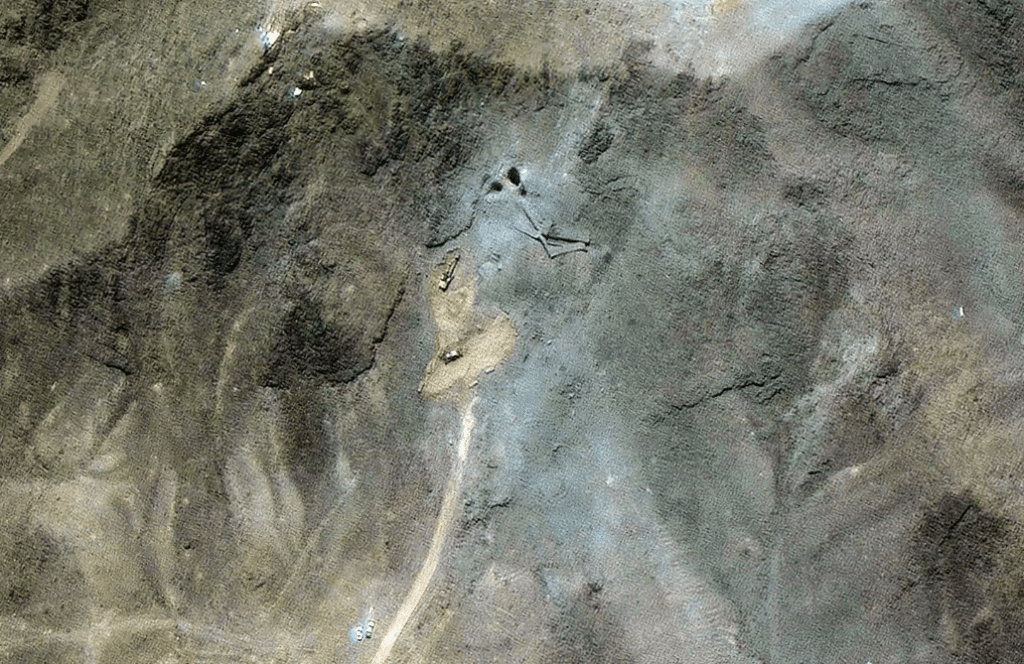By Staff Writer Seth B
The dusty access roads snaking toward Iran’s Fordow nuclear facility hadn’t seen this much activity in years—until now. High-resolution satellite imagery from early June reveals a surprising presence: clusters of heavy construction equipment, lowboy trailers hauling industrial containers, and a convoy of military-style trucks funneling in and out through multiple perimeter gates.

This would be unremarkable if not for the pronouncement made just days earlier by former President Donald Trump. In a late-night speech, he claimed the Fordow facility had been “obliterated” in a targeted strike—a declarative moment designed to resonate like a thunderclap across the geopolitical spectrum. But satellite data doesn’t lie. Fordow is still standing, and it’s anything but quiet.
The overhead footage was crisp enough to identify specific vehicle types—at least five wheeled cranes, several concrete mixers, and a staging area lined with what appeared to be blast-resistant shipping containers. Some analysts speculate they’re shielding sensitive equipment. Others wonder if they’re concealing something already extracted.
A close-up of the site’s primary tunnel entrance—a deeply buried section previously thought to be hardened against bunker-busting munitions—shows no signs of structural collapse. Adjacent retaining walls remain intact. No scorched earth. No rubble. Just well-worn tire tracks leading underground. Over 16 Trucks lined up at Fordow entrance
Iranian state media hasn’t acknowledged any military strike, but curiously, their news channels have aired footage of unrelated infrastructure projects, a classic sleight of hand used to distract from sensitive events. The silence around Fordow has been deafening.
Western intelligence sources remain publicly noncommittal, neither confirming nor denying Trump’s claim. But off the record, multiple analysts concede the imagery undercuts the narrative of total destruction. “If there was a strike,” one said, “it either failed to penetrate the mountain or it was a prelude to something else entirely.”
This opens the speculative floodgates. Was enriched plutonium—or highly enriched uranium—relocated before the alleged bombing? Fordow has long been suspected of housing advanced centrifuge arrays capable of producing weapons-grade material. If Tehran anticipated an attack, the relocation of its most sensitive stockpile wouldn’t just be likely—it would be logical.
The convoy patterns observed in the weeks leading up to the claimed obliteration support that timeline. Analysts noticed unusual traffic along Route 71, leading toward the city of Qom—then suddenly rerouted south. That southbound corridor aligns with satellite anomalies spotted near an obscure site in the Dasht-e Kavir desert.
Some believe that site may now be a fallback enrichment zone—hastily constructed or long-prepared. Either way, the timing is suspicious. Why activate a remote location just as Fordow was supposedly rendered inoperable?
Trump’s speech offered no imagery or documentation—just conviction. Supporters praised his decisiveness. Critics questioned whether he was briefed by credible sources or simply repackaging unverified intelligence. Meanwhile, the images from orbit tell their own, eerily silent story.
What’s clear is that Iran was ready. Whether through interception of signals intelligence or political anticipation, Tehran likely treated Fordow as a vulnerable asset. If key fissile material was smuggled out beforehand, it casts doubt not only on the efficacy of the strike but also on the transparency of those celebrating it.

There’s precedent for this kind of strategic theater. Israel’s 2007 strike on Syria’s Al Kibar reactor flattened the structure but missed critical equipment that had already been removed. Tehran, learning from history, may have staged its own game of nuclear musical chairs.
The visible presence of blast-rated containers and radiation shielding trucks at the Fordow perimeter is significant. These aren’t materials you deploy after a bombing. They’re protective and operational, not remedial. That implies ongoing work.
And the timing couldn’t be more politically charged. As nuclear deal negotiations remain frozen and regional tensions escalate, the Fordow narrative becomes more than a question of truth versus falsehood—it becomes a diplomatic chess piece.
The bigger risk? A false sense of resolution. If world leaders believe Fordow has been neutralized, pressure to monitor Iran’s other facilities may weaken. In reality, those facilities could be scaling up in the shadows.
The satellite imagery—a pixelated archive of quiet truths—suggests we’re not looking at a cratered relic but a reconfiguring hub. Fordow’s heart may still be beating, even if its pulse has gone subterranean. The image above showcases excavators busy at work
If the strike was real, its true target may not have been Fordow at all. Perhaps it was the narrative itself—an attempt to claim victory where ambiguity reigns. In the fog of strategic misdirection, perception becomes payload.
The images are still being analyzed. More will emerge. But for now, Fordow stands not as a monument to destruction, but as a symbol of how information warfare and geopolitical maneuvering have made even satellite evidence a contested battlefield
More to come on this confusing and misleading issue.





